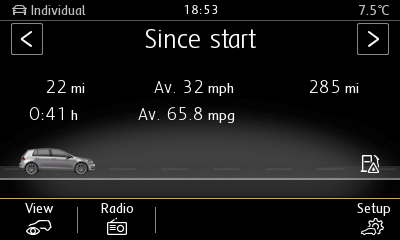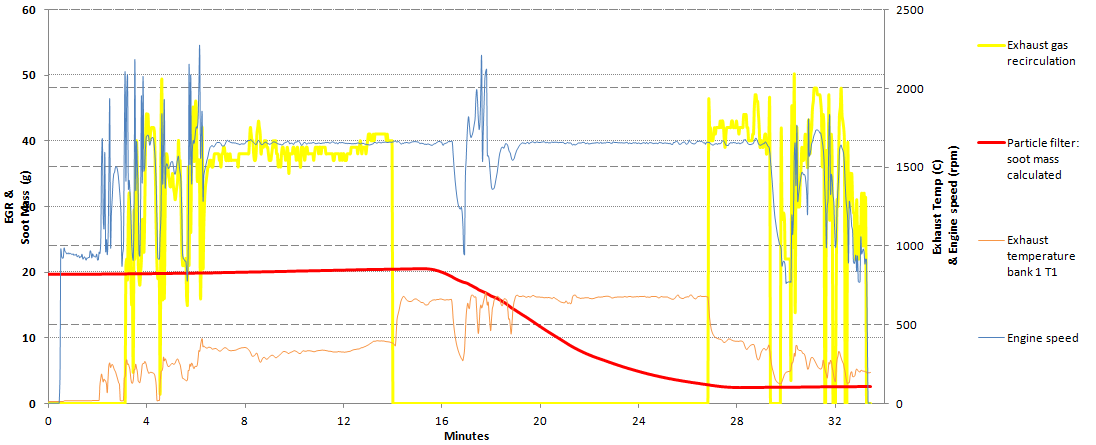Easy Diesel Particulate Filter (DPF) Active Regeneration
4th February 2017
Following on from my first article about the diesel particulate filter (DPF) in my Golf Mk 7, I have been using VCDS to learn more about how frequently active regeneration occurs. So far I have discovered the following:
- Passive regeneration alone is not enough to prevent the build up of soot in the DPF.
- Active regeneration is occurring approximately every 250miles (and this is with engine-friendly use, i.e. mainly longer journeys, motorway cruising, few short trips, little stop-start city-driving)
- Active regeneration is pretty much invisible to the driver whilst driving in terms of engine performance and fuel consumption. (See when active regeneration is in progress using the Infotainment system.)
With this knowledge I am now able to predict quite accurately when the next active regeneration is due. Yesterday, knowing that my next journey was likely to trigger another active regeneration, I plugged in my VCDS and captured the whole thing.
VCDS Logging
I used VCDS to log a number of DPF-related parameters during a single journey lasting just over 30 minutes.
The journey consisted mainly of driving 10 minutes down a relatively quiet dual carriageway at a cruise control regulated 55mph, turning around at a roundabout and driving back. More specifically:
Minute marker |
Miles |
Description |
|---|---|---|
0 - 2 |
0 |
Engine start and idling |
2 - 6 |
1.2 |
Urban (30mph limit) |
6 - 16 |
8.8 |
Steady 55mph using cruise control on quiet dual carriageway. |
16 - 19 |
1.1 |
Turnaround at roundabout. |
19 - 29 |
9.7 |
Steady 55mph using cruise control on quiet dual carriageway. |
29 - 33 |
1.4 |
Urban driving (30mph limit) |
The ambient temperature was around 7.5C throughout and the engine was started from cold. The thick yellow line shows an Exhaust Gas Recirculation (EGR) parameter. I'm not exactly sure what this parameter is but I do know that EGR is disabled during active regeneration and this parameter drops to zero indicating this.
From 6 minutes in, the engine speed (thin blue line) is 1,700rpm as the car begins cruising at 55mph in top (5th) gear. Exhaust gas temperature (thin orange line) is steady between 250-300°C. I observed the engine coolant temperature from the gauge on the dash and it wasn't until around the 12 minute mark that normal operating temperature (90°C) was reached. It was only a couple of minutes later (at 14 minutes) when active regeneration began.
Once active regeneration was initiated it took less than 30 seconds for the exhaust gas temperatures to jump to about 650°C. However it was another 2 minutes before calculated soot mass in the DPF (thick red line) began to fall. Similarly, soot mass continued to fall for a couple of minutes after the end of active regeneration at the 27 minute mark.
So the whole active regeneration process took only 13 minutes from start to finish. Except where the engine speed dropped between minutes 16 - 19 when I was maneuvering a roundabout, you can see that exhaust gas temperatures remained between 650-700°C throughout active regeneration. I didn't notice any change in the car's performance whilst this was going on, even when maneuvering around the roundabout.
When active regeneration finished I was still cruising at 55mph. However it took less than 30 seconds for exhaust gas temperatures to return to normal. Consequently, there was no need for the radiator cooling fans to run when I switched the engine off at the end of the trip about 7 minutes later.
Here's what the trip computer showed after this trip:

Trip Computer's statistics for this journey.
So if the DPF warning light illuminates on your car's dash, there's no need for sporty/high revving driving. A leisurely 30minute or so cruise down a dual carriageway should be all that is required to clear all the soot out of your car's DPF!
As always, I welcome any comments you may have on this topic.
